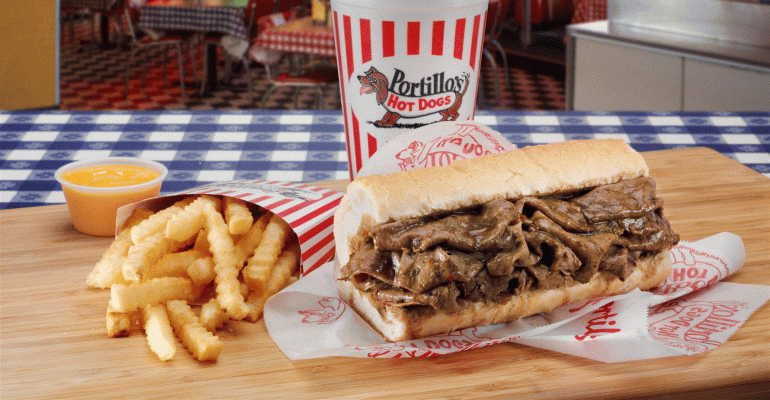Portillo’s has been a Chicagoland staple since its founding 60 years ago in Villa Park, Illinois. That’s not to say the company hasn’t found favor in other markets, however. In fact, CEO Michael Osanloo said recent openings outside of its core Midwest market have been performing even better.
During a presentation at the ICR Conference in Orlando, Osanloo, said a soft opening this week in The Colony, Texas, generated almost $20,000 in sales in just four hours without any marketing support, for instance.
“We didn’t tell anybody. There were no signs – nothing,” he said Tuesday morning. “Somehow people found out and there was a line out the door. They just kept lining up. I’ve never experienced that. Our restaurants come out of the gate hot.”
That can be a blessing and a curse, he added: “My biggest concern for Texas and Florida is we come out of the gate so hot, it’s hard to execute.”
Portillo’s, which went public in 2021 and now includes just over 70 locations, has about 10 restaurant openings planned this year, 70% of which are slated to open in the Sunbelt – Texas, Central Florida and Arizona. Those markets are targeted because they’re experiencing strong population growth and generating strong comps for the brand. Florida and Arizona are among the top 10 fastest-growing states throughout the past several decades, while Texas had the fastest-growing population in the U.S. in 2022, according to the U.S. Census Bureau.
CFO Michelle Hook said the company projects 10% growth on an annual basis and this year’s openings will be heavily loaded in the latter part of the year because of permitting and other delays throughout 2022. As the chain continues to expand beyond its core, one factor working in its favor is positive traffic trends despite higher menu prices. Traffic gains have become somewhat anomalous in the industry as restaurant operators continue to increase menu prices to manage relentlessly high inflation.
“We count the number of sandwiches and salads we sell and the number was positive in Q2, negative in Q2, positive in Q3 and trending in a positive direction in Q4. We feel very positive about that even with the macro headwinds,” Hook said.
Osanloo credited Portillo’s value proposition for maintaining positive traffic – a value proposition that is spread heavily via word-of-mouth, as the company itself spends less than half a point on marketing.
“Our marketing is having guests coming into our restaurant and having an amazing experience – getting a hot, fresh, fast, abundant meal at a sharp price point,” he said. “That meal is $9.75 on average. That’s a smoking hot deal. We think the guest notices these things. Whether or not the country tilts into a technical recession, the guest is challenged for 2023, so being in a value-oriented position is good for us.”
Portillo’s pricing increases averaged just under 8% in 2022, which lags the industry average of 8.5%. Hook said the company’s benchmark analysis finds Portillo’s bundle to be between $1 and $6 cheaper than its peers. This gap provides the chain with a little bit of wiggle room to take more pricing this year, and the company expects to inch up another 2% this month and then hold out until input costs become clearer.
“We’re not seeing any elasticity impact on pricing. It’s been well accepted by the guest. We feel we have a lot of latent pricing power,” Osanloo said. “We don’t do price willy nilly. We have eight different tiers of pricing, so it will be different in downtown Chicago than it is in Florida. We are surgical in where and how much we get to our pricing.”
Portillo’s has also been “surgical” about simplifying its operations to maximize efficiencies and promote a healthier workplace culture. Restaurants used to prep 27 different items in the morning, for instance. Now, they prep less than a dozen as the chain started sourcing pre-cut ingredients from its vendors.
The company is also undergoing a “Kitchen 23” initiative to achieve efficiencies. This effort has reduced the back-of-house walking route by 18 linear feet, Osanloo said.
“This has given us great CapEx savings and … 18 linear feet is a lot of walking done countless times throughout the day. It adds up,” he said. “These restaurants were designed in the 60s. We want to take a couple of steps out and make life easier for our team members. If team members are happy and we’re taking work out they don’t like to do anyway, that’s part of a virtuous cycle.”
Contact Alicia Kelso at [email protected]




